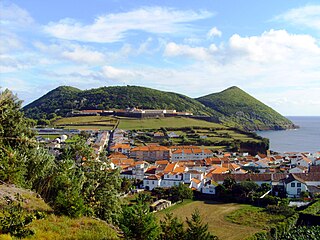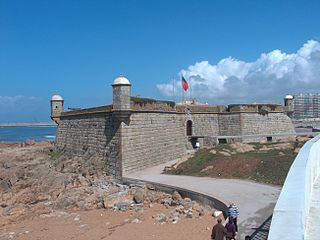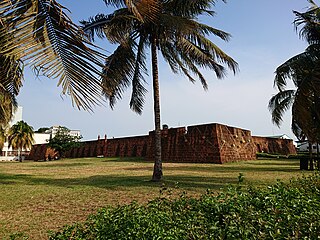
Lagos is a city and municipality at the mouth of Bensafrim River and along the Atlantic Ocean, in the Barlavento region of the Algarve, in southern Portugal. The population of the municipality in 2011 was 31,049, in an area of 212.99 km2. The city of Lagos proper has a population of approximately 22,000. Typically, these numbers increase during the summer months, with the influx of visiting tourists and seasonal residents. While the majority of the population lives along the coast and works in tourism and services, the inland region is sparsely inhabited, with the majority of the people working in agriculture and forestry.

Angra do Heroísmo, or simply Angra, is a city and municipality on Terceira Island, Portugal, and one of the three capital cities of the Azores. Founded in 1478, Angra was historically the most important city in the Azores, as seat of the Bishop of the Azores, government entities, and having previously served as the capital city of Portugal during the Liberal Wars. The population in 2011 was 35,402, in an area of 239.00 km². It was classified as a World Heritage site by UNESCO in 1983.

The Fortaleza do Monte is a fort in Santo António in Macau. It is the historical military centre of Macau. The fort forms part of the "Historic Centre of Macau" and is a UNESCO World Heritage Site.

Macau was under Portuguese rule from 1557 until 1999. During the final period of colonial administration prior to the handover to China, Portugal retained only limited numbers of military personnel in Macau for liaison and support purposes; the last major units having been withdrawn following the Carnation Revolution of 1974.

At the start of World War II in 1939, the Portuguese Government announced on 1 September that the 550-year-old Anglo-Portuguese Alliance remained intact, but since the British did not seek Portuguese assistance, Portugal was free to remain neutral in the war and would do so. In an aide-mémoire of 5 September 1939, the British Government confirmed the understanding. As Adolf Hitler's occupation swept across Europe, neutral Portugal became one of Europe's last escape routes. Portugal was able to maintain its neutrality until 1944, when a military agreement was signed to give the United States permission to establish a military base in Santa Maria in the Azores and thus its status changed to non-belligerent in favour of the Allies.

The Fortress of São João Baptista, also known as the Fort of São Filipe or Fort of Monte Brasil is a historic fortress and defensive emplacement, located in the civil parish of Sé, municipality of Angra do Heroísmo in the Portuguese island of Terceira, archipelago of the Azores.

The Passaleão incident, also known as the Battle of Passaleão or Baishaling incident, was a conflict between Portugal and China over Macau in August 1849. The Chinese were defeated in the only military confrontation, but the Portuguese called off further punitive measures after a naval explosion killed about 200 sailors.

Fort of São Francisco do Queijo, frequently shortened to Castle of the Cheese is a fortification situated along the coast of the civil parish of Nevogilde in the northern Portuguese municipality of Porto.
The Fort of Má Ferramenta, near the port of the civil parish of São Mateus da Calheta, municipality of Angra do Heroísmo, along the southern coast of the Portuguese island of Terceira, in the archipelago of the Azores. Located in a dominant position over this coastal stretch of coast that sheltered anchored ships, it was a fortification used as a defence against attacks from pirates and corsairs, that frequented the waters of the mid-Atlantic.

The Fort of Cinco Ribeiras, also known as the Fort of Nossa Senhora do Pilar or Fort of São Bartolomeu, ruins of a 16th-century fortification located in the municipality of Angra do Heroísmo, along the southeast coast of Terceira, Portuguese archipelago of the Azores.
The Fort of the Caninas, is a medieval fort situated in the Portugueses civil parish of Porto Judeu, municipality of Angra do Heroísmo, in the archipelago Azores.

São Marcelo Fort, also known as Forte de Nossa Senhora do Pópulo e São Marcelo or Forte do Mar, is located in Salvador in Bahia, Brazil. It is located in small bit of land off the coast in the Baía de Todos os Santos. Standing on a small bank of reefs about 300 metres (980 ft) from the coast, it is one of two forts separated by water from land in Brazil, the other being the Fort Tamandaré da Laje Tamandaré in Rio de Janeiro. It is the only cylindrical fort in Brazil. Its design follows those of Castel Sant'Angelo in Italy and São Lourenço do Bugio Fort in Portugal. It is popularly known as the "Forte do Mar". It was built to protect the important port city Salvador from threats; the city had the largest number of forts during the colonial period of Brazil.
The Fort of Greta is a fort along the promontory of Santa Catarina, on the western edge of the Bay of Mós, in the civil parish of Vila de São Sebastião, in the municipality of Angra do Heroísmo, on the Portuguese archipelago of the Azores.

The São Julião da Barra Fort is the largest and most complete military defense complex in the Vauban style remaining in Portugal. It is located in São Julião da Barra, on the point of São Gião, in the parish of Oeiras e São Julião da Barra, Paço de Arcos e Caxias, Oeiras Municipality, Lisbon District. Considered in the past as the most important maritime fortification in the country, it had originally, together with the Fort of São Lourenço do Bugio, the role of controlling access to the port of Lisbon. It is currently the official residence of the Portuguese Minister of National Defence.
The Fort of King Luís I, also referred to as the Fort of Caxias and the Fort-prison of Caxias, is located in the parish of Caxias, in the municipality of Oeiras in the Lisbon district of Portugal. It presently functions as a prison.

Asia was built at Bombay Dockyard in 1797. She made at least two voyages for the British East India Company (EIC) before the British Royal Navy purchased her in 1805 in the East Indies. The Royal Navy renamed her HMS Sir Francis Drake and used her as a frigate. She served in the Java campaign of 1811. When she returned to England in 1813 she was refitted as a storeship. Later, she became the flagship, at Newfoundland, for the governors of Newfoundland. The Admiralty sold her in 1825. New owners renamed her Asia and she sailed between Britain and London until 1831 when Portuguese interests purchased her. She then became the frigate Dona Maria II for the Liberal forces that were attempting to install the rightful queen, Dona Maria II, to the throne of Portugal, and overthrow Dom Miguel, who had usurped the throne. In early 1849 conflict developed between the Portuguese government in Macau and the Chinese government over who could collect taxes and tariffs at Macao. Dona Maria II sailed to Macao as part of a small squadron. An internal explosion destroyed her in the harbour on 29 October.

The Fort Nossa Senhora da Conceição of Lourenço Marques, nowadays known as the Maputo Fortress is located at Praça 25 de Junho and represents one of the main historical monuments of the city of Maputo, former Lourenço Marques, in Mozambique.

The Fort São Tiago da Barra also known as Barra Fort is located in the base of the Barra Hill, in front of Lapa Island in Macau, China, once one of the most important fortresses in the city.

The Fort Nossa Senhora do Bom Parto is a former fort of the Portuguese Empire located in Penha Hill in Macau, China.

The Fort São João da Barra also known as Fort São João Baptista or Fort Conceição, is located to the east of the town of Cabanas de Tavira, on a small hill below the Ria Formosa in the municipality of Tavira, in Algarve, southern Portugal.
















